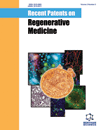- Home
- A-Z Publications
- Recent Patents on Regenerative Medicine
- Previous Issues
- Volume 1, Issue 3, 2011
Recent Patents on Regenerative Medicine - Volume 1, Issue 3, 2011
Volume 1, Issue 3, 2011
-
-
Recent Patents and Advances on Isolation and Cellular Therapy Applications of Mesenchymal Stem Cells from Human Umbilical Cord Wharton's Jelly
More LessAuthors: Rita Anzalone, Felicia Farina, Giovanni Zummo and Giampiero La RoccaIn recent years, important advances were made to clarify the biology and potential use of mesenchymal stem cells (MSC) in the therapy of a number of disorders. MSC are present in a number of tissues, ranging from adult bone marrow, to several adult organs, adipose tissue and, in the last years, the fetal-associated (also named as extraembryonic) tissues (e.g. placenta, amniotic membrane, umbilical cord). In particular Read More
-
-
-
Review of Recent Clinical Developments and Patents for the Treatment of Autoimmune and Inflammatory Diseases by Mesenchymal Stromal Cells
More LessAuthors: Sowmya Viswanathan and Yoko KosakaRecent observations that human mesenchymal stromal cells (MSCs) are non-immunogenic and possess the capacity to modulate the responses of immune cells has caused a fundamental paradigm shift in exploiting the therapeutic potential of MSCs. While MSCs are still being considered for regenerative purposes, particularly for musculoskeletal diseases, their role in treating inflammatory conditions, wound healing and imm Read More
-
-
-
Cardiac Tissue Engineering
More LessAuthors: Ming-Sing Si, Claus S. Sondergaard and Grant M. MathewsAcute and chronic heart failure and complex congenital heart disease result in inadequate cardiac output for which in vitro tissue engineering of implantable, functional cardiac tissue is an attractive alternative to heart transplantation, the gold-standard therapeutic modality which is severely limited by a donor organ shortage. A variety of strategies to generate, optimize, vascularize and implement engineered heart tissue (EH Read More
-
-
-
Recent Progress on Chemical Biology of Pluripotent Stem Cell Selfrenewal, Reprogramming and Cardiomyogenesis
More LessAuthors: Jijun Hao, Douglas B. Sawyer, Antonis K. Hatzopoulos and Charles C. HongPluripotent stem cells, such as embryonic stem (ES) cells and induced pluripotent stem (iPS) cells, hold great promise as a cell source for regenerative therapies to treat many major diseases characterized by an irreversible loss of functional tissues. However, the future clinical application of pluripotent stem cells faces a number of obstacles regarding the safety, efficiency and long-term benefits. Some of these Read More
-
-
-
Recent Patents on Cell-based Approaches to Collagen Enrichment and Repair
More LessAuthors: Devang K. Thakor, Alexander E. Ropper, Dou Yu, Inbo Han, Soo-Woo Kim, Serdar Kabatas and Yang D. TengCollagen is the most abundant protein in mammals and comprises about ninety percent of connective tissue. Thus, defective collagen can cause many health problems, particularly in the musculoskeletal system, including degenerative joint disease, degenerative spinal disc disorder, disc herniations, tendonitis/osis, osteoporosis, sprains and strains, etc. These pathological conditions, plus the fact that the tensile strength of Read More
-
-
-
Inhibitors of Myostatin- and Proteasome-Dependent Signaling for Attenuating Muscle Wasting
More LessAuthors: Kunihiro Sakuma and Akihiko YamaguchiMyostatin is a major negative regulator of muscle mass. Interestingly, myostatin can modulate the expression and functional activity of myogenic regulatory factors such as MyoD and Forkhead BoxO (FOXO). Recently, Akt, a crucial enhancer of muscle hypertrophy, has been shown to interact with Smad2 and 3, downstream of a myostatin-dependent pathway. Ubiquitin-proteasome signaling is the most common system of prot Read More
-
-
-
Current Status and Perspectives of Stem Cell Based Therapies for Liver Diseases
More LessAuthors: Ahmed M. El-Gohary, Fadia M. Attia and Fawzy A. KhalilLiver failure remains one of the major causes of morbidity and mortality in the world. All published studies about stem cell therapy at present are limited by small patient numbers and by the design as pilot safety and feasibility studies. Various experimental studies provided evidence that the infusion or injection of stem or progenitor cells may reduce liver fibrosis. Moreover, predominantly bone marrow-derived cells were sho Read More
-
-
-
Patent Selections
More LessThe recent patents annotated in this section have been selected from various patent databases, and are relevant to the articles published in this journal issue. The patents are categorized in fast emerging areas of regenerative medicine e.g. stem cells, human embryonic stem, gene therapy, tissue engineering, regenerative biomolecules, use of biomaterials for treating disease and injury, and tissue/ organ regeneration relate Read More
-
Volumes & issues
Most Read This Month
Article
content/journals/rpgm
Journal
10
5
false
en


